INTERNATIONAL
STANDARD
ISO/IEC
16022
Second edition
2006-09-15
Information technology — Automatic
identification and data capture
techniques — Data Matrix bar code
symbology specification
Technologies de l'information — Techniques d'identification
automatique et de capture des données — Spécification de symbologie
de code à barres Data Matrix
Reference number
ISO/IEC 16022:2006(E)
© ISO/IEC 2006
Copyright International Organization for Standardization Provided by IHS under license with ISO Not for ResaleNo reproduction or networking permitted without license from IHS--`,,```,,,,````-`-`,,`,,`,`,,`---�
ISO/IEC 16022:2006(E)
PDF disclaimer
This PDF file may contain embedded typefaces. In accordance with Adobe's licensing policy, this file may be printed or viewed but
shall not be edited unless the typefaces which are embedded are licensed to and installed on the computer performing the editing. In
downloading this file, parties accept therein the responsibility of not infringing Adobe's licensing policy. The ISO Central Secretariat
accepts no liability in this area.
Adobe is a trademark of Adobe Systems Incorporated.
Details of the software products used to create this PDF file can be found in the General Info relative to the file; the PDF-creation
parameters were optimized for printing. Every care has been taken to ensure that the file is suitable for use by ISO member bodies. In
the unlikely event that a problem relating to it is found, please inform the Central Secretariat at the address given below.
© ISO/IEC 2006
All rights reserved. Unless otherwise specified, no part of this publication may be reproduced or utilized in any form or by any means,
electronic or mechanical, including photocopying and microfilm, without permission in writing from either ISO at the address below or
ISO's member body in the country of the requester.
ISO copyright office
Case postale 56 • CH-1211 Geneva 20
Tel. + 41 22 749 01 11
Fax + 41 22 749 09 47
E-mail copyright@iso.org
Web www.iso.org
Published in Switzerland
ii
© ISO/IEC 2006 – All rights reserved
Copyright International Organization for Standardization Provided by IHS under license with ISO Not for ResaleNo reproduction or networking permitted without license from IHS--`,,```,,,,````-`-`,,`,,`,`,,`---�
ISO/IEC 16022:2006(E)
Contents
Page
Foreword........................................................................................................................................................... vii
Introduction ..................................................................................................................................................... viii
Scope ..................................................................................................................................................... 1
1
Normative references ........................................................................................................................... 1
2
Terms, definitions, symbols and abbreviated terms, and mathematical/logical notations .......... 2
3
Terms and definitions........................................................................................................................... 2
3.1
Symbols and abbreviations ................................................................................................................. 2
3.2
Mathematical/logical notations ........................................................................................................... 3
3.3
Symbol description............................................................................................................................... 3
4
Basic characteristics............................................................................................................................ 3
4.1
Summary of additional features .......................................................................................................... 4
4.2
Symbol structure .................................................................................................................................. 4
4.3
4.3.1 Finder pattern........................................................................................................................................ 5
4.3.2 Symbol sizes and capacities ............................................................................................................... 5
ECC 200 requirements.......................................................................................................................... 5
5
Encode procedure overview................................................................................................................ 5
5.1
Data encodation.................................................................................................................................... 6
5.2
5.2.1 Overview ................................................................................................................................................ 6
5.2.2 Default character interpretation .......................................................................................................... 6
5.2.3 ASCII encodation .................................................................................................................................. 7
5.2.4 Symbology control characters ............................................................................................................ 7
5.2.5 C40 encodation ..................................................................................................................................... 9
5.2.6 Text encodation .................................................................................................................................. 11
5.2.7 ANSI X12 encodation.......................................................................................................................... 11
5.2.8 EDIFACT encodation .......................................................................................................................... 12
5.2.9 Base 256 encodation .......................................................................................................................... 12
User considerations ........................................................................................................................... 13
5.3
5.3.1 User selection of Extended Channel Interpretation ........................................................................ 13
5.3.2 User selection of symbol size and shape ........................................................................................ 13
Extended Channel Interpretation ...................................................................................................... 13
5.4
5.4.1 Encoding ECIs..................................................................................................................................... 14
5.4.2 ECIs and Structured Append............................................................................................................. 15
5.4.3 Post-decode protocol......................................................................................................................... 15
ECC 200 symbol attributes ................................................................................................................ 15
5.5
5.5.1 Symbol sizes and capacity ................................................................................................................ 15
Insertion of Alignment Patterns into larger symbols...................................................................... 17
5.5.2
Structured Append ............................................................................................................................. 17
5.6
5.6.1 Basic principles .................................................................................................................................. 17
5.6.2 Symbol sequence indicator ............................................................................................................... 17
5.6.3 File identification ................................................................................................................................ 18
5.6.4 FNC1 and Structured Append ........................................................................................................... 18
5.6.5 Buffered and unbuffered operation .................................................................................................. 18
Error detection and correction .......................................................................................................... 18
5.7
5.7.1 Reed-Solomon error correction ........................................................................................................ 18
5.7.2 Generating the error correction codewords .................................................................................... 18
5.7.3 Error correction capacity ................................................................................................................... 19
Symbol construction .......................................................................................................................... 20
5.8
5.8.1 Symbol character placement............................................................................................................. 20
5.8.2 Alignment Pattern module placement .............................................................................................. 20
© ISO/IEC 2006 – All rights reserved
iii
Copyright International Organization for Standardization Provided by IHS under license with ISO Not for ResaleNo reproduction or networking permitted without license from IHS--`,,```,,,,````-`-`,,`,,`,`,,`---�
ISO/IEC 16022:2006(E)
5.8.3 Finder Pattern module placement ..................................................................................................... 20
ECC 000 - 140 requirements............................................................................................................... 21
6
Use recommendations........................................................................................................................ 21
6.1
Encode procedure overview .............................................................................................................. 21
6.2
Data encodation .................................................................................................................................. 21
6.3
6.3.1 Base 11 - Numeric encodation........................................................................................................... 23
6.3.2 Base 27 - Upper-case Alphabetic encodation.................................................................................. 23
6.3.3 Base 37 - Upper-case Alphanumeric encodation ............................................................................ 23
6.3.4 Base 41 - Upper-case Alphanumeric plus Punctuation encodation.............................................. 24
6.3.5 ASCII encodation ................................................................................................................................ 24
6.3.6 8-bit byte encodation .......................................................................................................................... 24
User selection of error correction level ............................................................................................ 24
6.4
6.4.1 Selection of error correction level..................................................................................................... 24
6.4.2 Other error correction levels based on convolutional code algorithms ....................................... 25
Constructing the Unprotected Bit Stream ........................................................................................ 25
6.5
6.5.1 Format ID Bit Field .............................................................................................................................. 25
6.5.2 CRC Bit Field ....................................................................................................................................... 25
6.5.3 Data Length Bit Field .......................................................................................................................... 25
6.5.4 Data prefix construction..................................................................................................................... 25
6.5.5 Completing the Unprotected Bit Stream........................................................................................... 26
Constructing the Unrandomised Bit Stream.................................................................................... 26
6.6
6.6.1 Header construction ........................................................................................................................... 26
6.6.2 Applying convolutional coding to create the Protected Bit Stream .............................................. 26
6.6.3 Trailer construction ............................................................................................................................ 27
6.6.4 Completing the Unrandomised Bit Stream....................................................................................... 27
Pattern randomising ........................................................................................................................... 27
6.7
Module placement in matrix............................................................................................................... 27
6.8
Symbol dimensions ............................................................................................................................ 27
7
Dimensions.......................................................................................................................................... 27
7.1
Quiet zone............................................................................................................................................ 27
7.2
Symbol quality..................................................................................................................................... 27
8
Symbol quality parameters ................................................................................................................ 28
8.1
8.1.1 Fixed pattern damage ......................................................................................................................... 28
8.1.2 Scan grade and overall symbol grade .............................................................................................. 28
8.1.3 Grid non-uniformity ............................................................................................................................ 28
Process control measurements......................................................................................................... 28
8.2
Reference decode algorithm for Data Matrix ................................................................................... 28
9
User guidelines ................................................................................................................................... 38
10
10.1 Human readable interpretation.......................................................................................................... 38
10.2 Autodiscrimination capability............................................................................................................ 38
System considerations....................................................................................................................... 38
10.3
Transmitted data ................................................................................................................................. 38
11
Protocol for FNC1 (ECC 200 only)..................................................................................................... 38
11.1
Protocol for FNC1 in the second position (ECC 200 only) ............................................................. 38
11.2
Protocol for Macro characters in the first position (ECC 200 only)............................................... 38
11.3
Protocol for ECIs (ECC 200 only) ...................................................................................................... 39
11.4
Symbology identifier........................................................................................................................... 39
11.5
Transmitted data example.................................................................................................................. 39
11.6
Annex A (normative) ECC 200 interleaving process...................................................................................... 40
Schematic illustration......................................................................................................................... 40
A.1
Starting sequence for interleaving in different sized symbols ...................................................... 40
A.2
Annex B (normative) ECC 200 pattern randomising...................................................................................... 43
253-state algorithm ............................................................................................................................. 43
B.1
B.1.1 253-state randomising algorithm....................................................................................................... 43
B.1.2 253-state un-randomising algorithm................................................................................................. 43
255-state algorithm ............................................................................................................................. 44
B.2
iv
© ISO/IEC 2006 – All rights reserved
Copyright International Organization for Standardization Provided by IHS under license with ISO Not for ResaleNo reproduction or networking permitted without license from IHS--`,,```,,,,````-`-`,,`,,`,`,,`---�
ISO/IEC 16022:2006(E)
B.2.1 255-state randomising algorithm ...................................................................................................... 44
B.2.2 255-state un-randomising algorithm................................................................................................. 44
Annex C (normative) ECC 200 encodation character sets............................................................................ 45
C40 encodation character set............................................................................................................ 45
C.1
Text encodation character set........................................................................................................... 46
C.2
EDIFACT encodation character set................................................................................................... 47
C.3
Annex D (normative) ECC 200 alignment patterns ........................................................................................ 48
Annex E (normative) ECC 200 Reed-Solomon error detection and correction .......................................... 50
Error correction codeword generator polynomials......................................................................... 50
E.1
Error correction calculation............................................................................................................... 52
E.2
Calculation of error correction codewords...................................................................................... 53
E.3
Annex F (normative) ECC 200 symbol character placement........................................................................ 55
Symbol character placement............................................................................................................. 55
F.1
Symbol character placement rules ................................................................................................... 57
F.2
F.2.1 Non-standard symbol character shapes .......................................................................................... 57
F.2.2 Symbol character arrangement......................................................................................................... 60
Symbol character placement examples for ECC 200...................................................................... 63
F.3
Annex G (normative) ECC 000 - 140 symbol attributes................................................................................. 68
ECC 000 ............................................................................................................................................... 68
G.1
ECC 050 ............................................................................................................................................... 69
G.2
ECC 080 ............................................................................................................................................... 70
G.3
ECC 100 ............................................................................................................................................... 71
G.4
ECC 140 ............................................................................................................................................... 72
G.5
Annex H (normative) ECC 000 - 140 data module placement grids ............................................................. 73
Annex I (normative) ECC 000 - 140 character encodation schemes............................................................ 90
Base 11 encodation scheme.............................................................................................................. 94
I.1
First stage procedure ......................................................................................................................... 94
I.1.1
Second stage procedure.................................................................................................................... 94
I.1.2
Example ............................................................................................................................................... 94
I.1.3
Base 27 encodation scheme.............................................................................................................. 95
I.2
First stage procedure ......................................................................................................................... 95
I.2.1
Second stage procedure.................................................................................................................... 95
I.2.2
Example ............................................................................................................................................... 95
I.2.3
Base 37 encodation scheme.............................................................................................................. 96
I.3
First stage procedure ......................................................................................................................... 96
I.3.1
Second stage procedure.................................................................................................................... 96
I.3.2
Example ............................................................................................................................................... 96
I.3.3
Base 41 encodation scheme.............................................................................................................. 97
I.4
First stage procedure ......................................................................................................................... 97
I.4.1
Second stage procedure.................................................................................................................... 97
I.4.2
Example ............................................................................................................................................... 97
I.4.3
Annex J (normative) ECC 000 - 140 CRC algorithm ...................................................................................... 98
CRC state machine ............................................................................................................................. 98
J.1
CRC polynomial .................................................................................................................................. 98
J.2
CRC 2-byte header.............................................................................................................................. 98
J.3
Annex K (normative) ECC 000 - 140 error checking and correcting algorithms ...................................... 100
ECC 000 ............................................................................................................................................. 100
K.1
ECC 050 ............................................................................................................................................. 100
K.2
ECC 080 ............................................................................................................................................. 100
K.3
ECC 100 ............................................................................................................................................. 100
K.4
ECC 140 ............................................................................................................................................. 100
K.5
Processing the convolutional code ................................................................................................ 100
K.6
Convolutional codes reference decode algorithm ........................................................................ 101
K.7
Annex L (normative) ECC 000 - 140 Master Random Bit Stream (in hexadecimal).................................. 104
© ISO/IEC 2006 – All rights reserved
v
Copyright International Organization for Standardization Provided by IHS under license with ISO Not for ResaleNo reproduction or networking permitted without license from IHS--`,,```,,,,````-`-`,,`,,`,`,,`---�
ISO/IEC 16022:2006(E)
Annex M (normative) Data Matrix print quality – symbology-specific aspects ........................................ 105
Data Matrix Fixed Pattern Damage.................................................................................................. 105
M.1
M.1.1 Features to be assessed .................................................................................................................. 105
M.1.2 Grading of the outside L of the fixed pattern ................................................................................. 105
M.1.3 Grading of the clock track and adjacent solid area segments..................................................... 107
M.1.4 Calculation and grading of average grade ..................................................................................... 111
Scan grade......................................................................................................................................... 112
M.2
Annex N (normative) Symbology identifier................................................................................................... 113
Annex O (informative) ECC 200 encode example......................................................................................... 114
Annex P (informative) Encoding data using the minimum symbol data characters for ECC 200........... 116
Annex Q (informative) ECC 000 - 140 encode example using ECC 050..................................................... 120
Encode example................................................................................................................................ 120
Q.1
CRC calculation for example ........................................................................................................... 125
Q.2
Annex R (informative) Useful process control techniques ......................................................................... 128
Symbol contrast ................................................................................................................................ 128
R.1
Special reference symbol................................................................................................................. 128
R.2
Assessing Axial Nonuniformity....................................................................................................... 129
R.3
Visual inspection for symbol distortion and defects .................................................................... 129
R.4
Annex S (informative) Autodiscrimination capability .................................................................................. 130
Annex T (informative) System considerations ............................................................................................. 131
Bibliography ................................................................................................................................................... 132
vi
© ISO/IEC 2006 – All rights reserved
Copyright International Organization for Standardization Provided by IHS under license with ISO Not for ResaleNo reproduction or networking permitted without license from IHS--`,,```,,,,````-`-`,,`,,`,`,,`---�
ISO/IEC 16022:2006(E)
Foreword
ISO (the International Organization for Standardization) and IEC (the International Electrotechnical
Commission) form the specialized system for worldwide standardization. National bodies that are members of
ISO or IEC participate in the development of International Standards through technical committees
established by the respective organization to deal with particular fields of technical activity. ISO and IEC
technical committees collaborate in fields of mutual interest. Other international organizations, governmental
and non-governmental, in liaison with ISO and IEC, also take part in the work. In the field of information
technology, ISO and IEC have established a joint technical committee, ISO/IEC JTC 1.
International Standards are drafted in accordance with the rules given in the ISO/IEC Directives, Part 2.
The main task of the joint technical committee is to prepare International Standards. Draft International
Standards adopted by the joint technical committee are circulated to national bodies for voting. Publication as
an International Standard requires approval by at least 75 % of the national bodies casting a vote.
Attention is drawn to the possibility that some of the elements of this document may be the subject of patent
rights. ISO and IEC shall not be held responsible for identifying any or all such patent rights.
ISO/IEC 16022 was prepared by Joint Technical Committee ISO/IEC JTC 1, Information technology,
Subcommittee SC 31, Automatic identification and data capture techniques.
This second edition cancels and replaces the first edition (ISO/IEC 16022:2000), which has been technically
revised. It also incorporates the Technical Corrigendum ISO/IEC 16022:2000/Cor.1:2004.
© ISO/IEC 2006 – All rights reserved
vii
Copyright International Organization for Standardization Provided by IHS under license with ISO Not for ResaleNo reproduction or networking permitted without license from IHS--`,,```,,,,````-`-`,,`,,`,`,,`---�
ISO/IEC 16022:2006(E)
Introduction
Data Matrix is a two-dimensional matrix symbology which is made up of nominally square modules arranged
within a perimeter finder pattern. Though primarily shown and described in this International Standard as a
dark symbol on light background, Data Matrix symbols can also be printed to appear as light on dark.
Manufacturers of bar code equipment and users of the technology require publicly available standard
symbology specifications to which they can refer when developing equipment and application standards. The
publication of standardised symbology specifications is designed to achieve this.
viii
© ISO/IEC 2006 – All rights reserved
Copyright International Organization for Standardization Provided by IHS under license with ISO Not for ResaleNo reproduction or networking permitted without license from IHS--`,,```,,,,````-`-`,,`,,`,`,,`---�
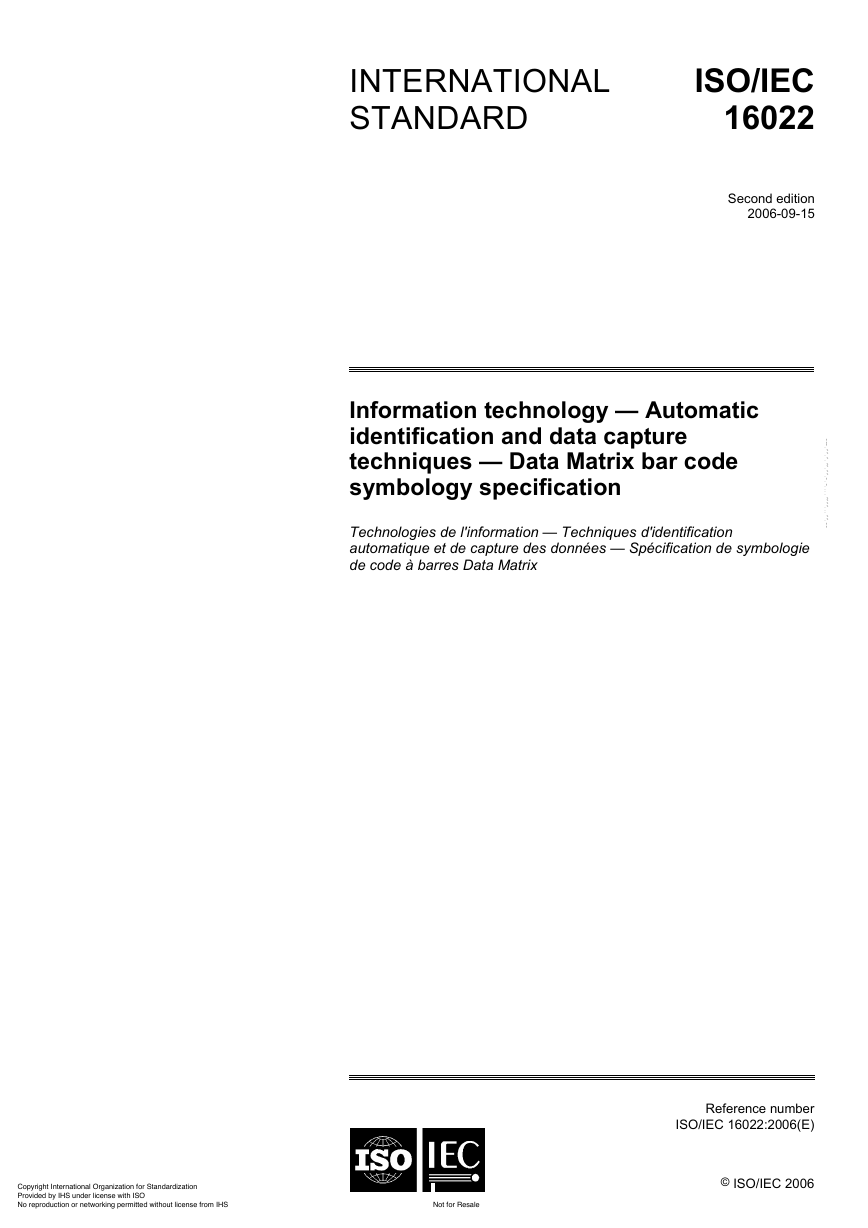
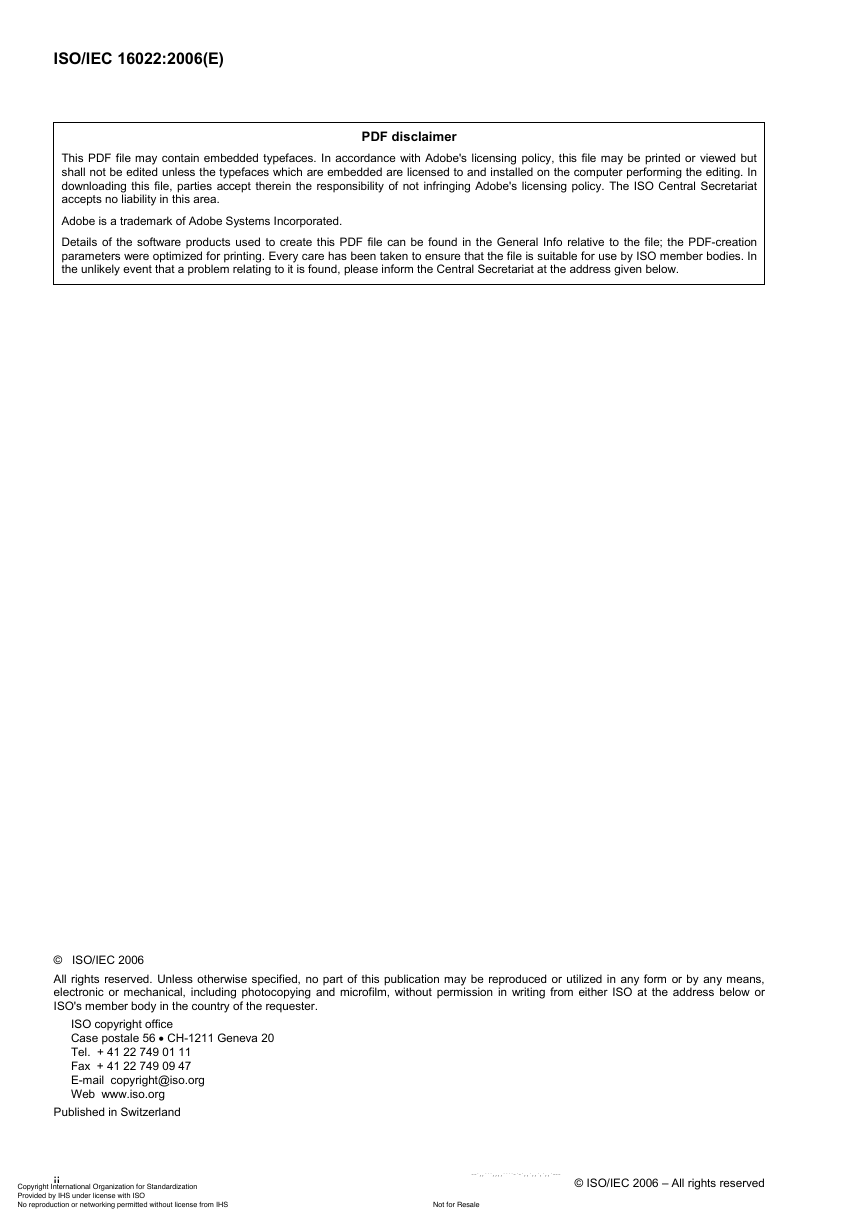
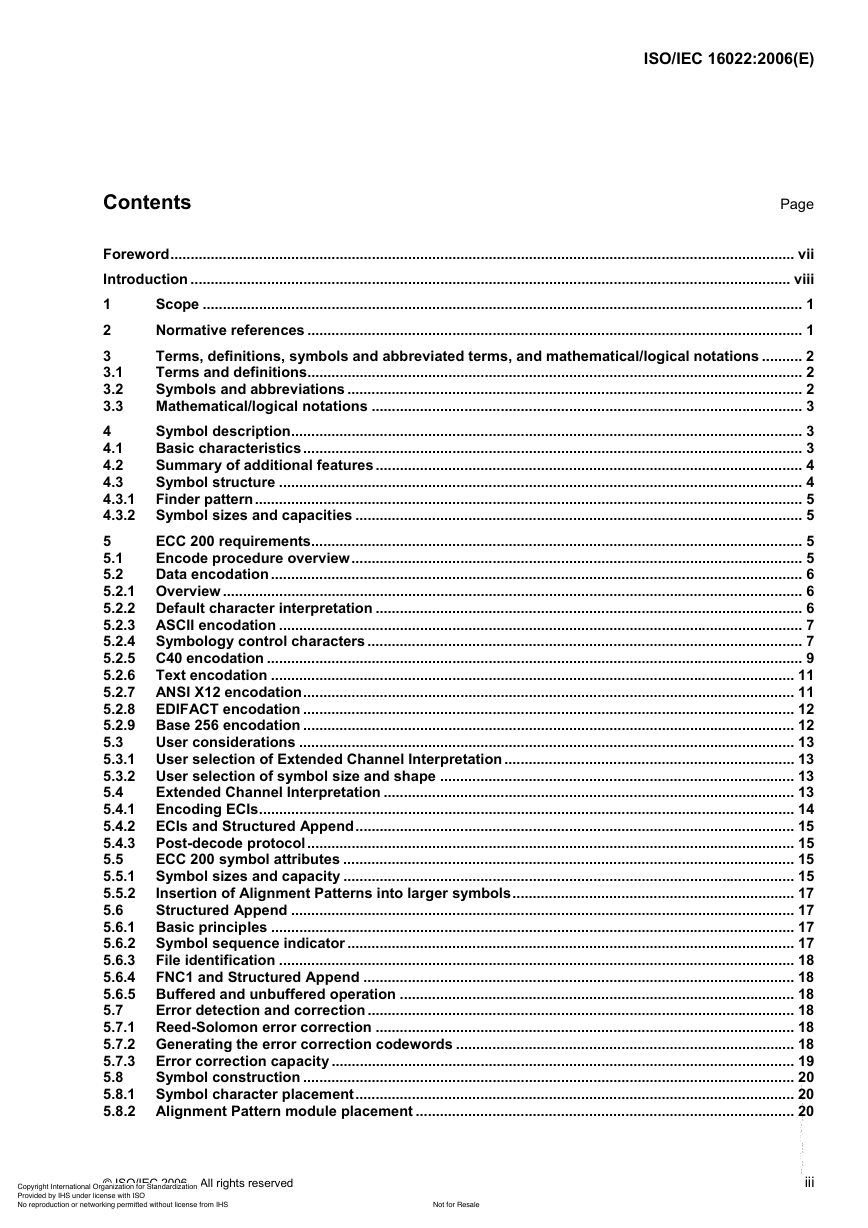
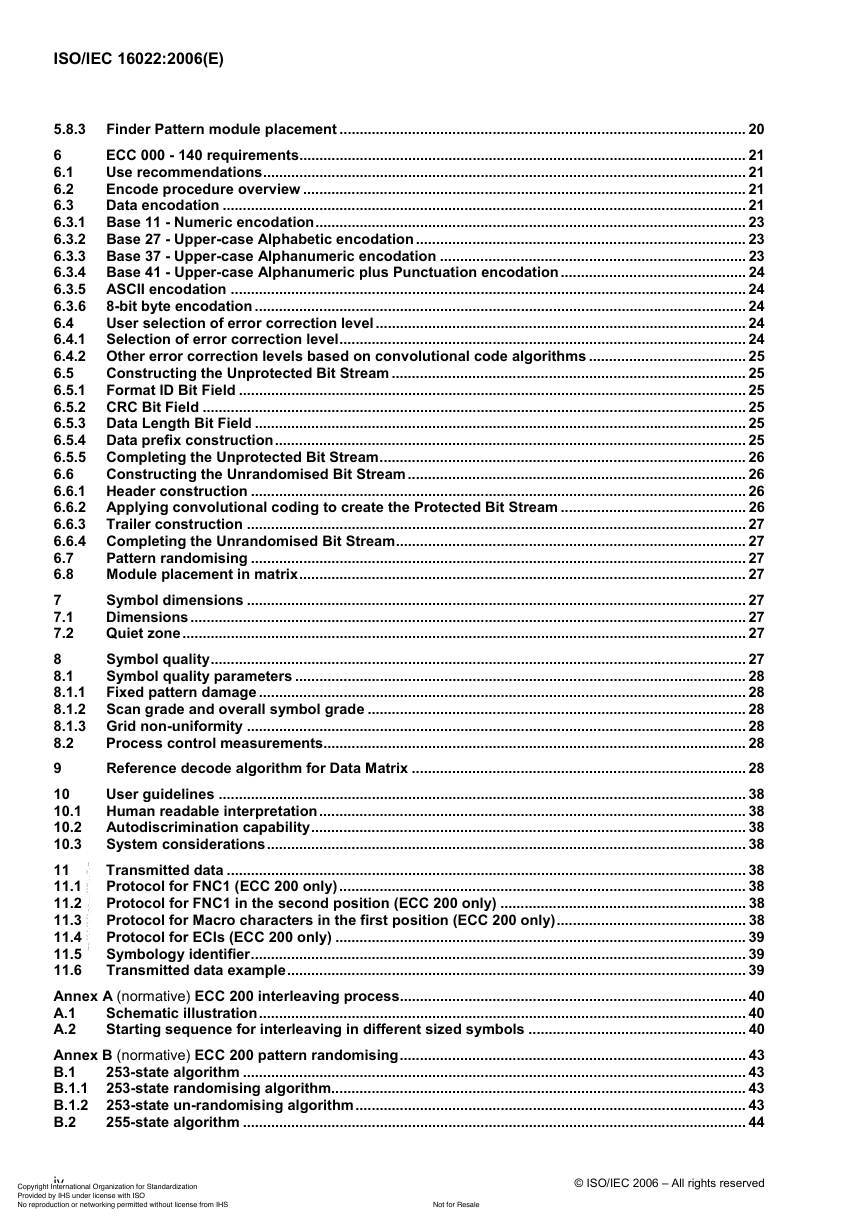
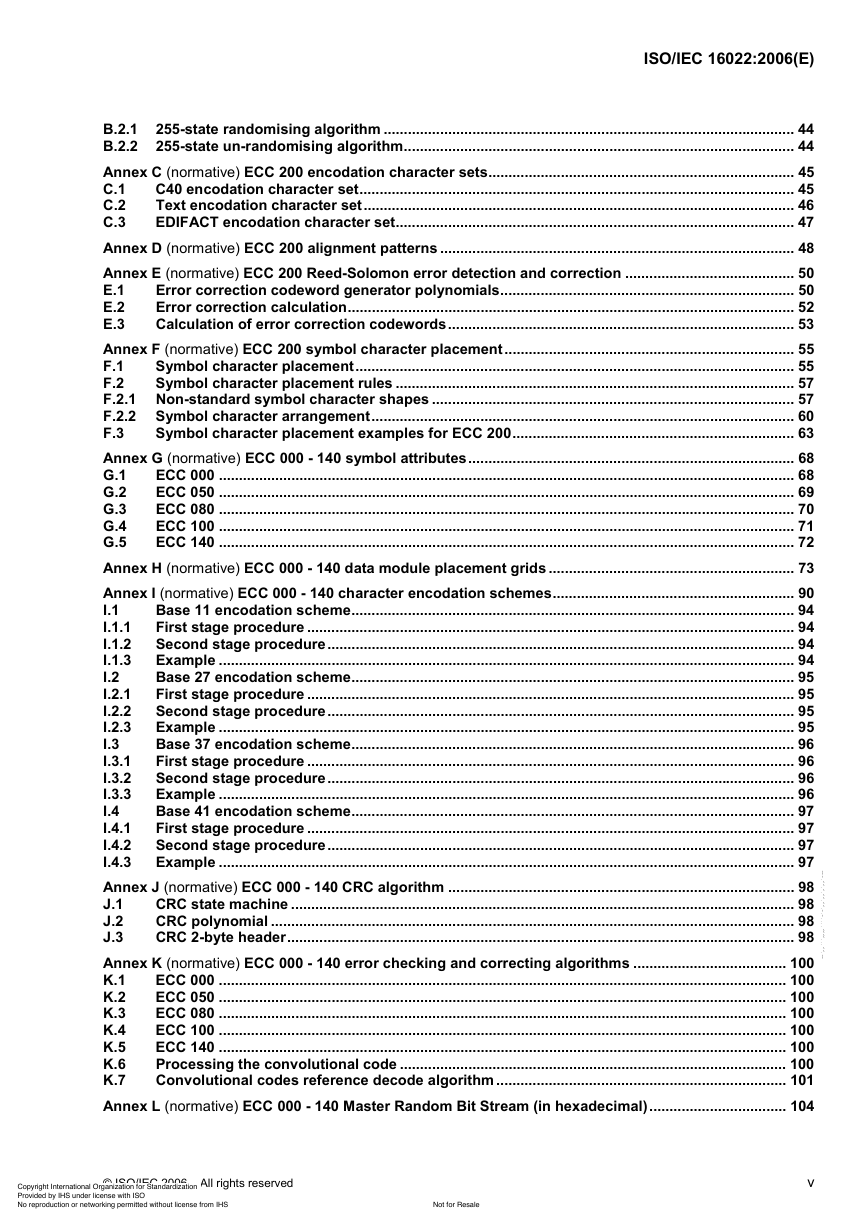
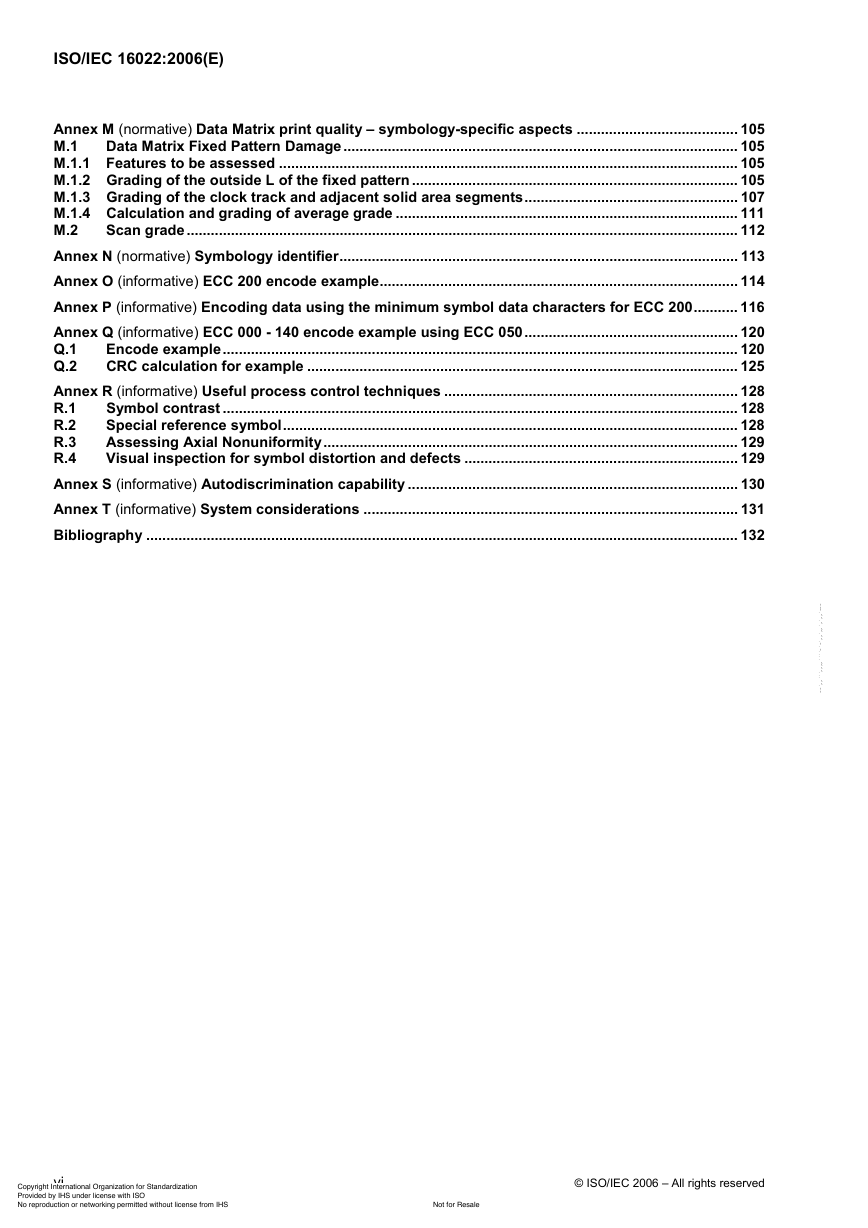
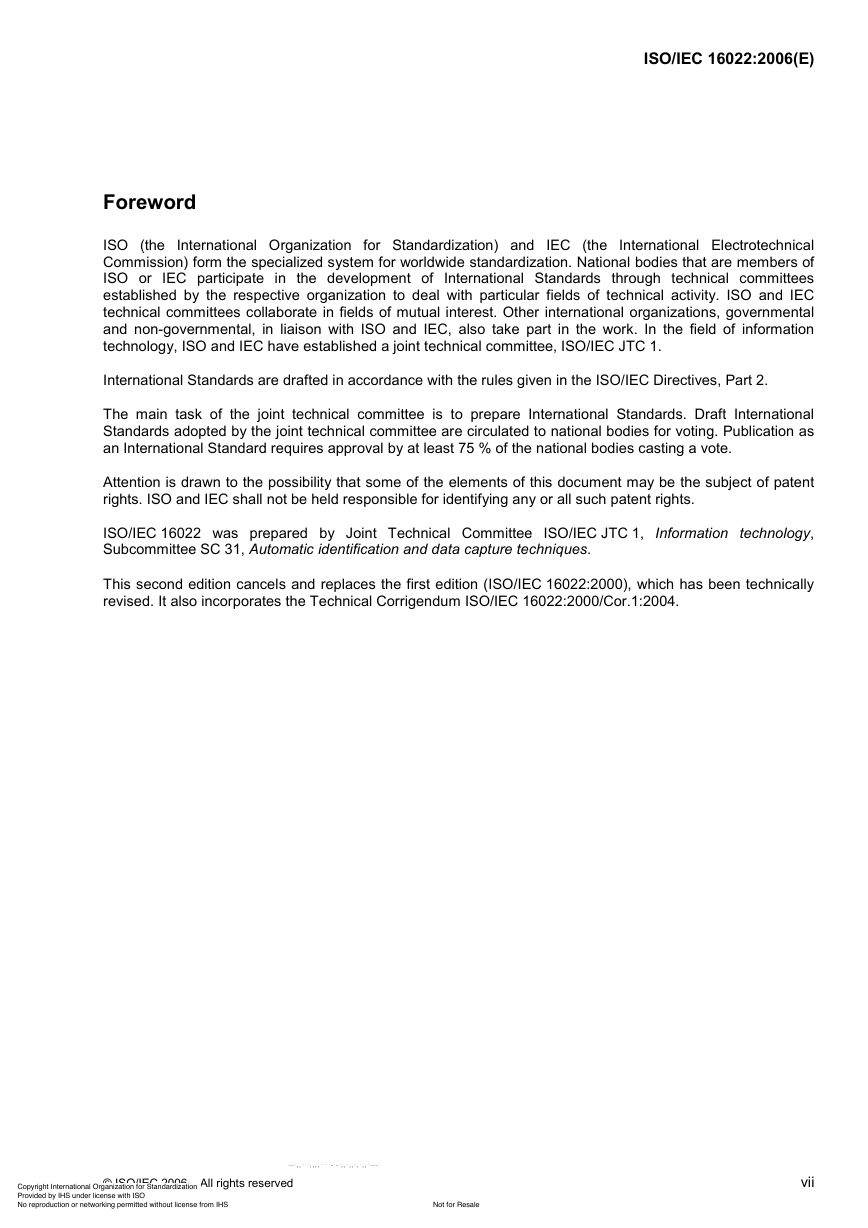
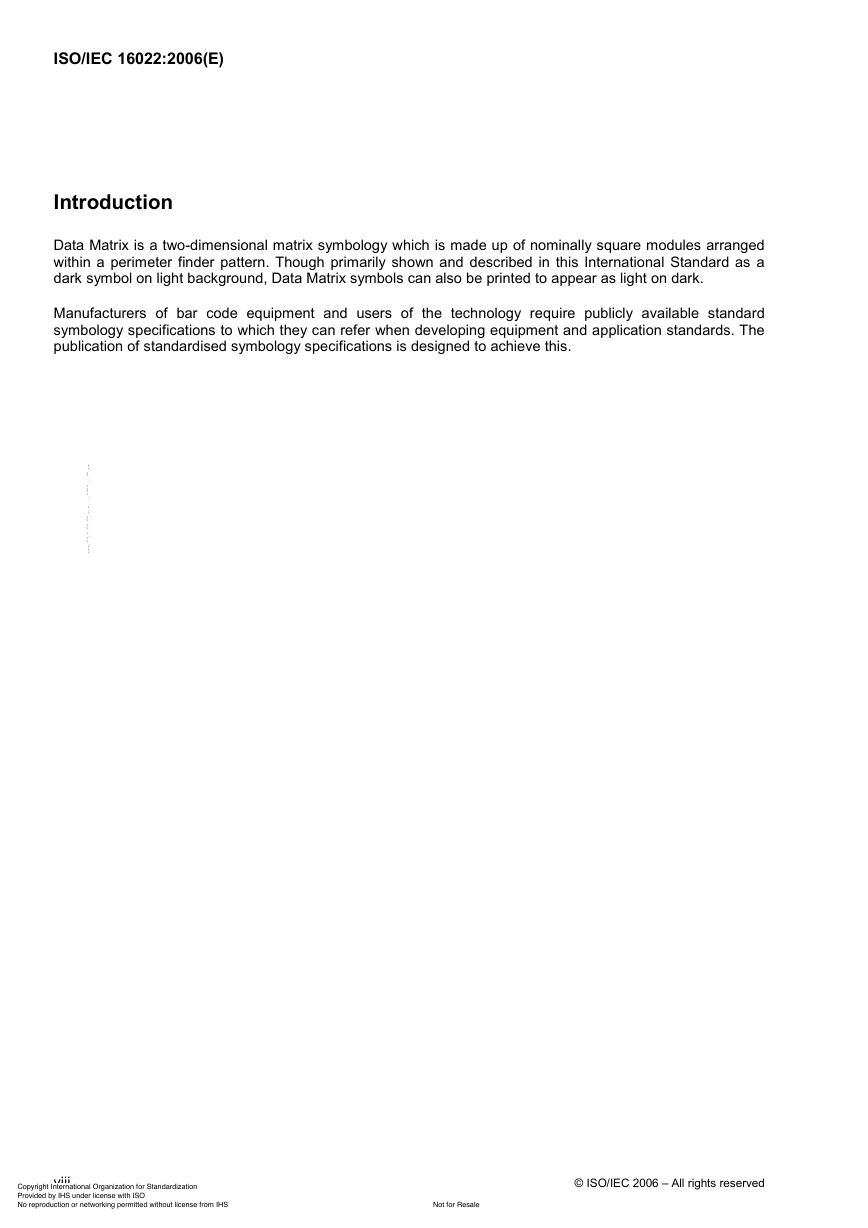








 2023年江西萍乡中考道德与法治真题及答案.doc
2023年江西萍乡中考道德与法治真题及答案.doc 2012年重庆南川中考生物真题及答案.doc
2012年重庆南川中考生物真题及答案.doc 2013年江西师范大学地理学综合及文艺理论基础考研真题.doc
2013年江西师范大学地理学综合及文艺理论基础考研真题.doc 2020年四川甘孜小升初语文真题及答案I卷.doc
2020年四川甘孜小升初语文真题及答案I卷.doc 2020年注册岩土工程师专业基础考试真题及答案.doc
2020年注册岩土工程师专业基础考试真题及答案.doc 2023-2024学年福建省厦门市九年级上学期数学月考试题及答案.doc
2023-2024学年福建省厦门市九年级上学期数学月考试题及答案.doc 2021-2022学年辽宁省沈阳市大东区九年级上学期语文期末试题及答案.doc
2021-2022学年辽宁省沈阳市大东区九年级上学期语文期末试题及答案.doc 2022-2023学年北京东城区初三第一学期物理期末试卷及答案.doc
2022-2023学年北京东城区初三第一学期物理期末试卷及答案.doc 2018上半年江西教师资格初中地理学科知识与教学能力真题及答案.doc
2018上半年江西教师资格初中地理学科知识与教学能力真题及答案.doc 2012年河北国家公务员申论考试真题及答案-省级.doc
2012年河北国家公务员申论考试真题及答案-省级.doc 2020-2021学年江苏省扬州市江都区邵樊片九年级上学期数学第一次质量检测试题及答案.doc
2020-2021学年江苏省扬州市江都区邵樊片九年级上学期数学第一次质量检测试题及答案.doc 2022下半年黑龙江教师资格证中学综合素质真题及答案.doc
2022下半年黑龙江教师资格证中学综合素质真题及答案.doc